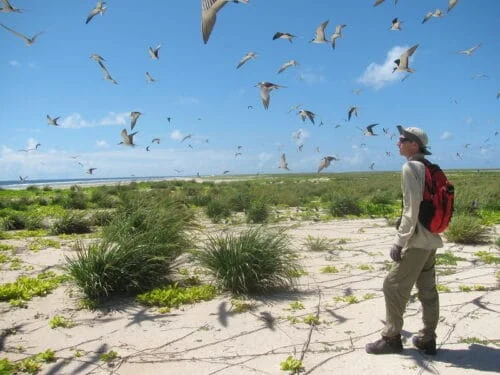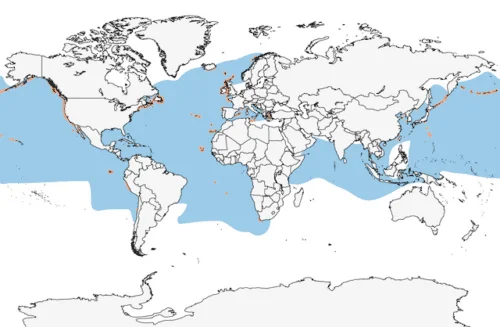The Northern Storm Petrel (Hydrobates pelagicus) is the world’s smallest seabird, captivating bird enthusiasts with its miniature size and incredible oceanic journeys.
Welcome back to our nature blog, where we explore the fascinating realm of wildlife with a light-hearted and informative approach.
Today, we’re setting sail on an adventure to learn more about the world’s smallest seabird, the Northern Storm Petrel! Despite their diminutive stature, these incredible birds are true oceanic explorers, undertaking extraordinary migrations across vast distances.
So, let’s embark on a voyage to uncover more about these tiny seabirds and their awe-inspiring lives at sea.

The Northern Storm Petrel (Hydrobates pelagicus) is the smallest member of the seabird family, measuring only 14-16 cm in length and weighing a mere 20-30 grams.
These petite birds belong to the family Hydrobatidae and are found in the North Atlantic and Mediterranean Sea. Northern Storm Petrels have predominantly dark plumage with a white rump patch, which distinguishes them from other storm petrel species.
Migrations
One of the most remarkable aspects of the Northern Storm Petrel’s life is its incredible migratory journey. After breeding, these tiny seabirds undertake a long-distance migration, traveling thousands of miles to their wintering grounds off the coast of Africa and South America.
These extraordinary journeys showcase the Northern Storm Petrel’s impressive navigational skills and endurance, as they traverse vast oceanic distances despite their small size.

Habitat and Distribution: Where to Find the World’s Smallest Seabird
If you’re a birdwatcher or simply curious about the world’s smallest seabird, you might be wondering where you can catch a glimpse of the Northern Storm Petrel. The best time to observe these elusive birds is during their breeding season, which typically takes place between May and August.
They can be found nesting on rocky islands and coastal cliffs in the North Atlantic and Mediterranean Sea.
To increase your chances of spotting these enigmatic seabirds, consider joining a pelagic birdwatching trip or visiting a known breeding colony during the breeding season.
Remember to bring along a good pair of binoculars and exercise patience, as these tiny birds can be quite difficult to spot amidst the vast ocean or among the rocky terrain where they nest.

Diet and Hunting: The Smallest Seabird in the World
The diet of the Northern Storm Petrel primarily consists of small fish, planktonic crustaceans, and fish eggs.
They have a unique feeding technique, known as surface pattering, which involves hovering just above the water and using their feet to “patter” the surface, attracting prey within reach of their sharp beaks. This fascinating feeding strategy allows them to capture food in the open ocean without the need to dive beneath the surface.
Love in Small Packages: Mating and Reproduction
Northern Storm Petrels are colonial nesters, returning to land only during the breeding season to lay their eggs and raise their young. They prefer nesting in rocky crevices, burrows, or even man-made structures, such as stone walls or buildings.
These nocturnal birds are highly secretive when it comes to their nesting habits, typically visiting their nests under the cover of darkness to avoid predation. Both parents share the responsibility of incubating the single egg laid and caring for the chick once it hatches.
Conservation Status
While the Northern Storm Petrel is not currently considered endangered, it does face threats that could impact its long-term survival. Climate change, overfishing, pollution, and predation by invasive species, such as rats and cats, pose significant challenges for these tiny seabirds.
Conservation efforts are essential to ensure the continued survival of the Northern Storm Petrel and the health of the marine ecosystems they inhabit.
These efforts include monitoring populations, protecting breeding sites, implementing measures to reduce bycatch in fishing nets, and raising awareness about the importance of preserving marine habitats and their unique biodiversity.
Fun Fact
The Northern Storm Petrel has an extraordinary ability to locate food in the vast open ocean, thanks to a keen sense of smell.
Unlike most birds, which have a limited sense of smell, Northern Storm Petrels possess an olfactory system that allows them to detect the scent of a substance called dimethyl sulfide (DMS). DMS is produced when plankton is consumed by marine animals, such as fish and krill.
By following the scent of DMS, these tiny seabirds can locate areas of the ocean with abundant food sources, making their incredible foraging journeys in the open ocean much more efficient and successful.
Conclusion
The Northern Storm Petrel, the world’s smallest seabird, is a fascinating and inspiring example of the wonders of the natural world.
With their incredible oceanic migrations, unique feeding techniques, and secretive nesting habits, these tiny birds capture the imagination of bird enthusiasts and nature lovers alike.
By continuing to learn about and protect the Northern Storm Petrel, we can help ensure their survival and the health of the marine ecosystems they call home. So, the next time you find yourself gazing out across the open ocean, keep an eye out for these diminutive navigators – you might just be fortunate enough to witness the captivating world of the Northern Storm Petrel!
